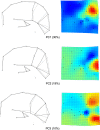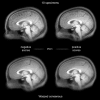Midsagittal brain variation and MRI shape analysis of the precuneus in adult individuals
- PMID: 24397462
- PMCID: PMC4489922
- DOI: 10.1111/joa.12155
Midsagittal brain variation and MRI shape analysis of the precuneus in adult individuals
Abstract
Recent analyses indicate that the precuneus is one of the main centres of integration in terms of functional and structural processes within the human brain. This neuroanatomical element is formed by different subregions, involved in visuo-spatial integration, memory and self-awareness. We analysed the midsagittal brain shape in a sample of adult humans (n = 90) to evidence the patterns of variability and geometrical organization of this area. Interestingly, the major brain covariance pattern within adult humans is strictly associated with the relative proportions of the precuneus. Its morphology displays a marked individual variation, both in terms of geometry (mostly in its longitudinal dimensions) and anatomy (patterns of convolution). No patent differences are evident between males and females, and the allometric effect of size is minimal. However, in terms of morphology, the precuneus does not represent an individual module, being influenced by different neighbouring structures. Taking into consideration the apparent involvement of the precuneus in higher-order human brain functions and evolution, its wide variation further stresses the important role of these deep parietal areas in modern neuroanatomical organization.
Keywords: brain geometry; geometric morphometrics; parietal lobe; shape variation.
© 2014 Anatomical Society.
Figures





Similar articles
-
Cortical surface area and cortical thickness in the precuneus of adult humans.Neuroscience. 2015 Feb 12;286:345-52. doi: 10.1016/j.neuroscience.2014.11.063. Epub 2014 Dec 8. Neuroscience. 2015. PMID: 25499315
-
Midsagittal Brain Variation among Non-Human Primates: Insights into Evolutionary Expansion of the Human Precuneus.Brain Behav Evol. 2017;90(3):255-263. doi: 10.1159/000481085. Epub 2017 Oct 25. Brain Behav Evol. 2017. PMID: 29065406 Free PMC article.
-
Precuneus proportions and cortical folding: A morphometric evaluation on a racially diverse human sample.Ann Anat. 2017 May;211:120-128. doi: 10.1016/j.aanat.2017.02.003. Epub 2017 Mar 6. Ann Anat. 2017. PMID: 28279731 Review.
-
The brain and the braincase: a spatial analysis on the midsagittal profile in adult humans.J Anat. 2015 Sep;227(3):268-76. doi: 10.1111/joa.12355. Epub 2015 Jul 21. J Anat. 2015. PMID: 26200138 Free PMC article.
-
The precuneus: a review of its functional anatomy and behavioural correlates.Brain. 2006 Mar;129(Pt 3):564-83. doi: 10.1093/brain/awl004. Epub 2006 Jan 6. Brain. 2006. PMID: 16399806 Review.
Cited by
-
Functional craniology and brain evolution: from paleontology to biomedicine.Front Neuroanat. 2014 Apr 2;8:19. doi: 10.3389/fnana.2014.00019. eCollection 2014. Front Neuroanat. 2014. PMID: 24765064 Free PMC article. Review.
-
Language, Paleoneurology, and the Fronto-Parietal System.Front Hum Neurosci. 2017 Jun 30;11:349. doi: 10.3389/fnhum.2017.00349. eCollection 2017. Front Hum Neurosci. 2017. PMID: 28713257 Free PMC article. No abstract available.
-
Dynamic and static brain functional abnormalities in autism patients at different developmental stages.Neuroreport. 2025 Mar 5;36(4):202-210. doi: 10.1097/WNR.0000000000002139. Epub 2025 Feb 12. Neuroreport. 2025. PMID: 39976045 Free PMC article.
-
Morphological Features of Human Dendritic Spines.Adv Neurobiol. 2023;34:367-496. doi: 10.1007/978-3-031-36159-3_9. Adv Neurobiol. 2023. PMID: 37962801 Review.
-
Brain ontogeny and life history in Pleistocene hominins.Philos Trans R Soc Lond B Biol Sci. 2015 Mar 5;370(1663):20140062. doi: 10.1098/rstb.2014.0062. Philos Trans R Soc Lond B Biol Sci. 2015. PMID: 25602066 Free PMC article. Review.
References
-
- Ashburner J, Friston KJ. Voxel-based morphometry – The Methods. NeuroImage. 2000;11:805–821. - PubMed
-
- Ashburner J, Friston KJ. Why voxel-based morphometry should be used. NeuroImage. 2001;14:1238–1243. - PubMed
-
- Bookstein FL. Morphometric Tools for Landmark Data: Geometry and Biology. Cambridge: Cambridge University Press; 1991.
-
- Bookstein FL. “Voxel-based morphometry” should not be used with imperfectly registered images. NeuroImage. 2001;14:1454–1462. - PubMed
Publication types
MeSH terms
LinkOut - more resources
Full Text Sources
Other Literature Sources

